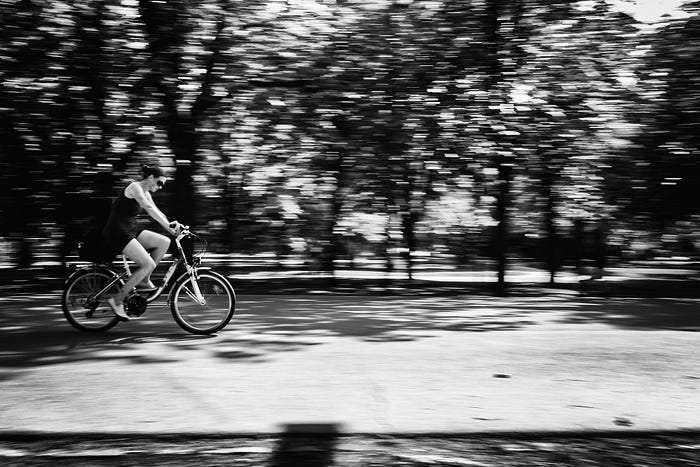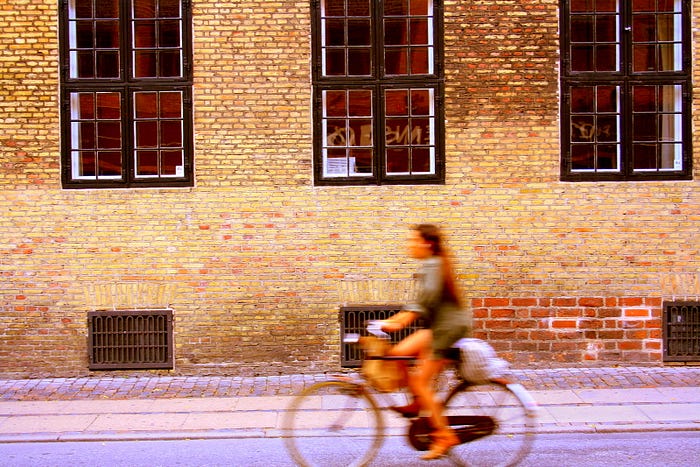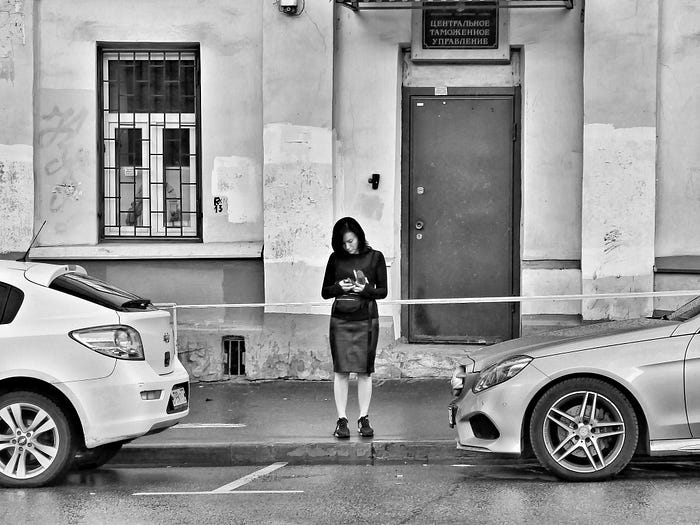

Why Cycling Improves My Thinking
source link: https://clivethompson.medium.com/why-cycling-improves-my-thinking-dd3074a8dc31
Go to the source link to view the article. You can view the picture content, updated content and better typesetting reading experience. If the link is broken, please click the button below to view the snapshot at that time.
Why Cycling Improves My Thinking
I get clarity — and a big-picture view — when I’m on two wheels

Three months ago I wrote about how cycling improved my mental health. As I noted, going for a ride nearly always makes me feel better:
If I were worried? A brisk ride would part the clouds. If I felt pissy, it’d expel the yellow bile. If I were blocked or stuck on a piece of work — or uncertain about a decision? A ride brought blessed clarity. I’d return home knowing exactly what to do.
I want to explore more deeply that last point: How cycling gives me clarity when I’m thinking through a problem.
Why does it do that? How does it do that?
It really does! When I’m cycling, I find that I get a lot of really useful thinking done. My mind seems to float free of everyday worries that normally peck at me like pissy little ducks. When I’m in the saddle and racing along, I find myself more easily able to take a big-picture view.
I think it has to do with the curious balance between a) the demands that cycling places on my mind and body and b) the freedoms that it imparts. There’s something alchemical going on that catalyzes a truly useful mental state, and one that’s qualitatively different from when I’m sitting at home, reading, walking, or talking to other people.
The cognitive quality of cycling is caused, I think, by these aspects of the activity …

“cycling (panning)” by d26b73
1) Cycling only *gently* occupies your mind
Technically speaking, cycling is a mentally demanding task. You have to keep constantly balancing on the thing while navigating, right?
Except balancing and navigating are a super automatic activity. You don’t have to think about them. Indeed, “it’s as easy as riding a bike” is our go-to metaphor for tasks we can perform with a joyful mindless, as Jody Rosen notes in his wonderful new book Two Wheels Good: The History and Mystery of The Bicycle:
In recent years, researchers gained greater understanding of the process as a guide or master of bike riding. Scientists have identified a nerve cell, the molecular layer interneuron, the controls signal output from the cerebellum, which translates a newly learned motor skill like cycling into a code that is engraved as memory elsewhere in the brain. It is an example of a so-called procedural memory: like walking or talking or tying your shoelaces, bike riding is a motor function that, once learned, we can perform automatically, with a request to conscious thought. In fact cycling is the most famous example of procedural memory. "It's just like riding a bike," we say, describing something that becomes second nature, an activity we can pick up where we left off, no matter how much time has elapsed.
Cycling, in other words, is custom-designed to create a very chill flow state — a situation where we’re continually needing to exert ourselves, but in an utterly manageable way. I think this is a key part of why cycling feels like such a great time for thinking.

“Road, cyclist, trees” by Sherry Galey
2) Cycling feeds your mind with tons of sensory stimulus
Cycling is a feast for the senses. When I’m riding along the streets of New York, there’s a nonstop gallery of visual beauty (artful graffiti, soaring architecture, lush parks), sounds (snatches of overheard conversation, bits of music blasting from storefronts, moments of surprising quiet on one-way side-streets), and smells (roasted meats from food trucks, unexpected bursts of flowers in pots, and plenty of car exhaust). Riding in the countryside brings me gorgeous fields and forests, with all their sights and sounds too.
This stuff is also coming at you with a pace that’s interestingly different from the rest of life: Faster than walking, but slower than a car.
The upshot is your senses feel like they’re constantly engaged in a non-stressed fashion — like you body is constantly taking notes on the world around you.
The writer Valeria Luiselli captures a bit of this when she notes that cycling …
… possesses a strange freedom that can only be compared with that of thinking or writing… Skimming along on two wheels, the rider finds just the right piece for observing the city and being at once its accomplice and its witness."
(That quote is from Rosen’s book.)
What’s more, when I’m cycling in a city, things are always a bit dangerous. That seems to make my senses — and my mind, really — as alert as those of a wolf. When I come back from a ride (as I wrote in my previous piece), “I feel like I’ve microdosed the pure essence of urban life. I’ve been in the world.”

“Cycling” by Jaume Escofet
3) These two modes interact in a nearly-musical fashion
So cycling creates both a) a chill flow-state, while also b) requiring a type of heightened sensory alertness. I have a hunch these two modes, which are sort of in opposition to one another, interact in an interesting way.
To use a musical metaphor, it’s like the interplay between drone strings and the active notes on an instrument. When I play slide guitar, I’ll set up a constant thrum on the low G, while playing leads and riffs high up on the neck. What makes the overall sound so pleasurable (to me, anyway) is the interactions and divergences between the persistent drone and the flittering riffs.
That’s precisely how my mind feels when I’m cycling. The physical act of cycling creates a physical “drone”; the sensory banquet of the road brings the riffs. Together, they create an overall mental noise and counterpoint that primes my mind for terrifically creative thought.

by Zhivko Dmitrov via Pixabay
4) There’s plenty of time for active thinking
When you’re cycling, you have to pay attention to the road. You can’t fully zone out.
But there’s still plenty of reasonably calm time — like when I’m going down a long and empty street, or gliding through a park, or idling a stop light, or slowly climbing a long hill.
That means there’s lots of mental room for active thinking. By “active” I mean that I can pick something that’s specifically bugging me — some difficult research I’m hashing through, or a personal dilemma, or a song lyric I’ve been trying to write, or the structure of an article draft I can’t quite fashion — and mull it over.
And there’s quite a lot of this time, if the bike ride is long! Even short errands tend to give me 15 minutes of cycling; meeting someone in Manhattan for lunch often means an hour and a half of cycling during a business day. And a few times a year I do a 100-mile “century”, which is about nine hours in the saddle.
(A side note: Cycling also tricks me into spending more time thinking than I’d normally set aside. If I do a 45 minute ride to dinner with a friend, I’m forced to do a 45 minute ride back. Cycling is a sneaky trap you lay for yourself: Once you’ve arrived at your destination, you’ve got to cycle back, even if you don’t feel like it.)

“Lady in black” by Sergei F
5) There are few technological distractions on a cycle
Let’s say I cycle to meet a friend for lunch, and spend an hour total going there and back. That’s one hour of time for thinking.
In the rest of my life, I rarely spend that much time only thinking. If I’m sitting around the house, I might spend some minutes staring into space, pondering something. But more likely than not I’d flip open my laptop to do some reading, or I’d look at a book or a magazine, or I’d dork around on social media. Obviously, if I’m reading something deep or informative, I’m doing a lot of useful thinking there, too. But it’s cognitive work that’s triggered by media.
But with cycling, you cannot seriously consume visual media at all. You can peek at your phone during a stop light, or riskily glance at a message while zipping along an empty street. (Dangerous; one shouldn’t do it; yet I sometimes do.)
Mostly, cycling gives me a space for thinking that is uniquely uninterrupted by messages, posts, or media. It’s just me focusing on my thoughts, with a brain that’s buzzing in the perfect state for nuanced, creative thinking.
(Technically, one could listen to audio media on a bike, like podcasts or music. But I never do that. For safety’s sake, I want to hear exactly what’s going on in the world around me.)
Recommend
About Joyk
Aggregate valuable and interesting links.
Joyk means Joy of geeK